
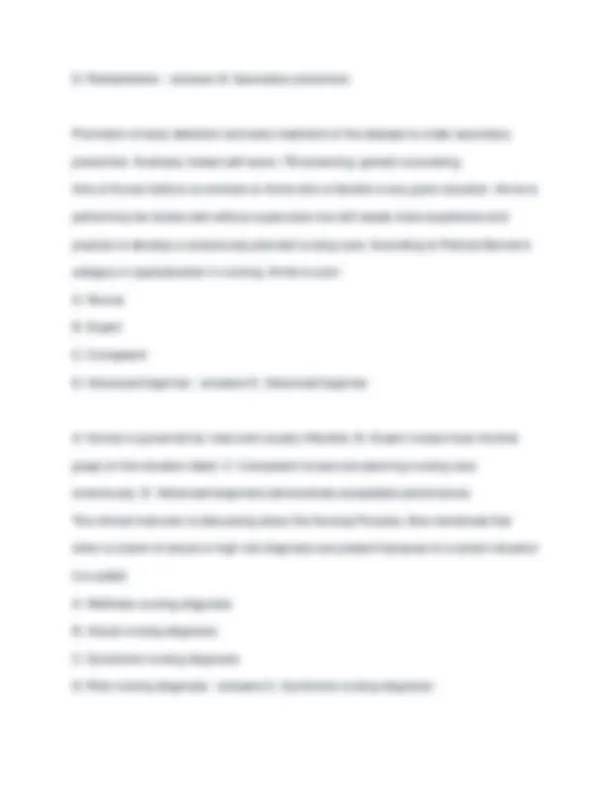
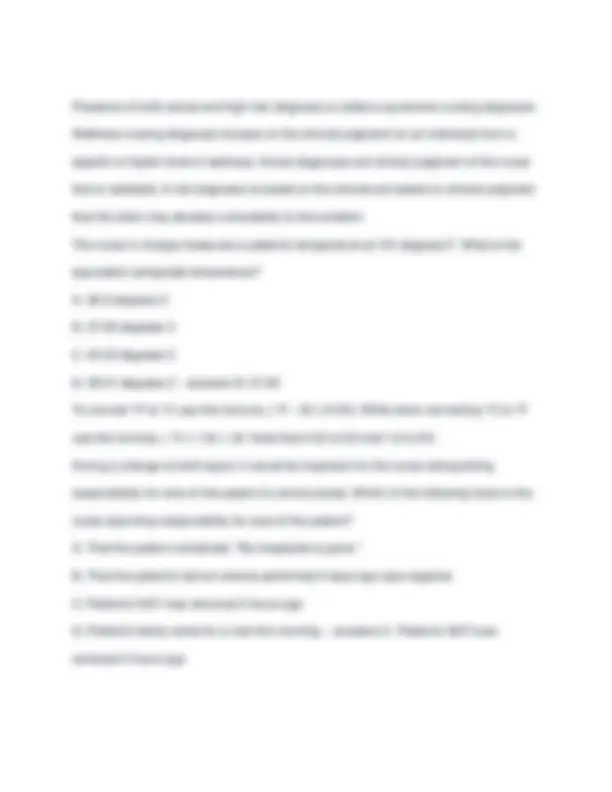
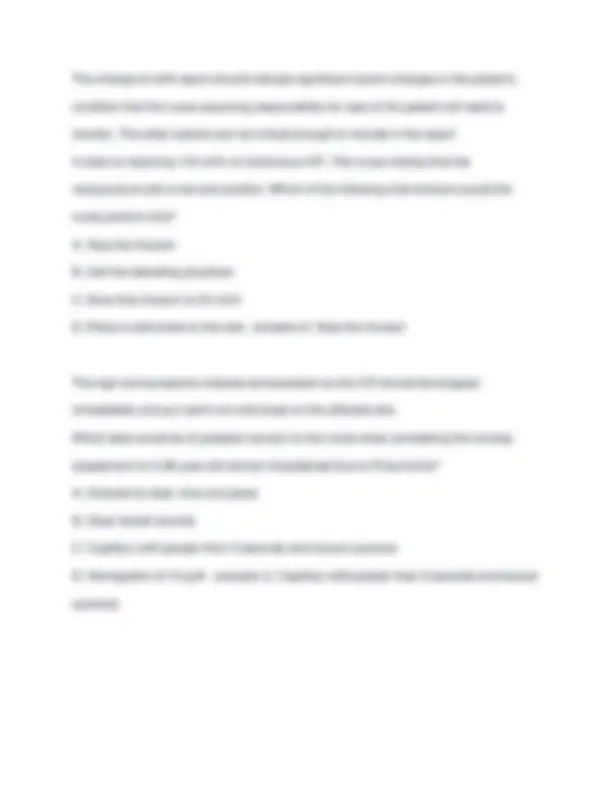
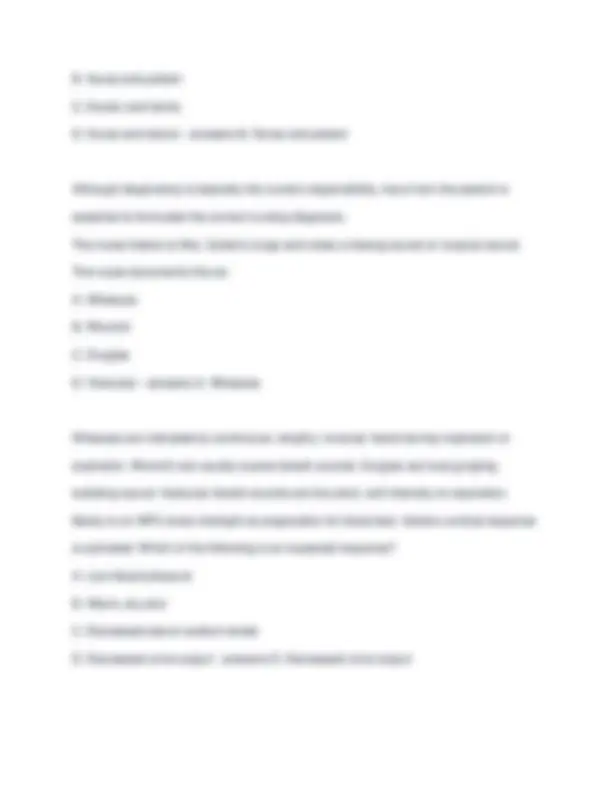
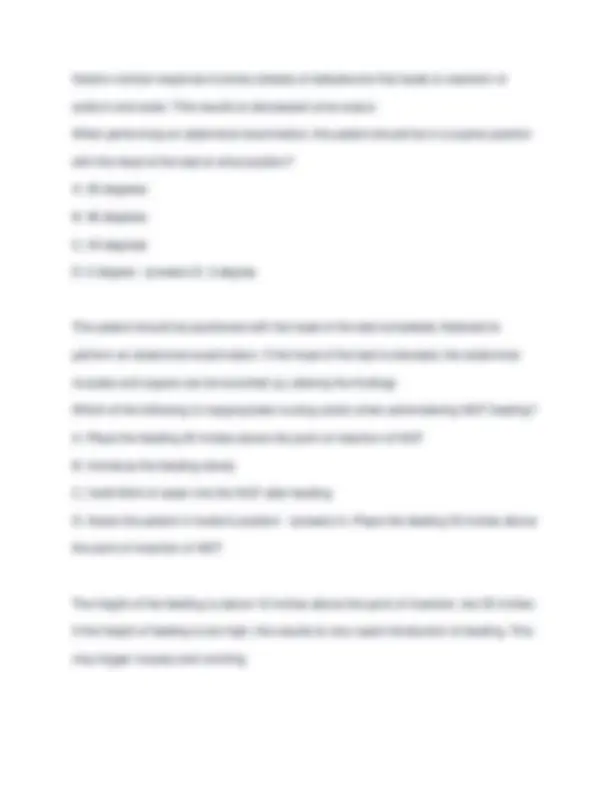
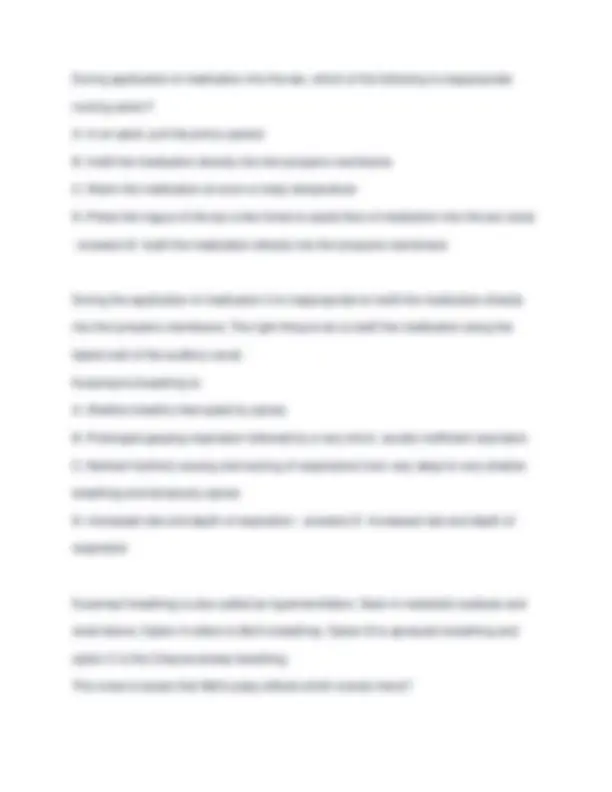
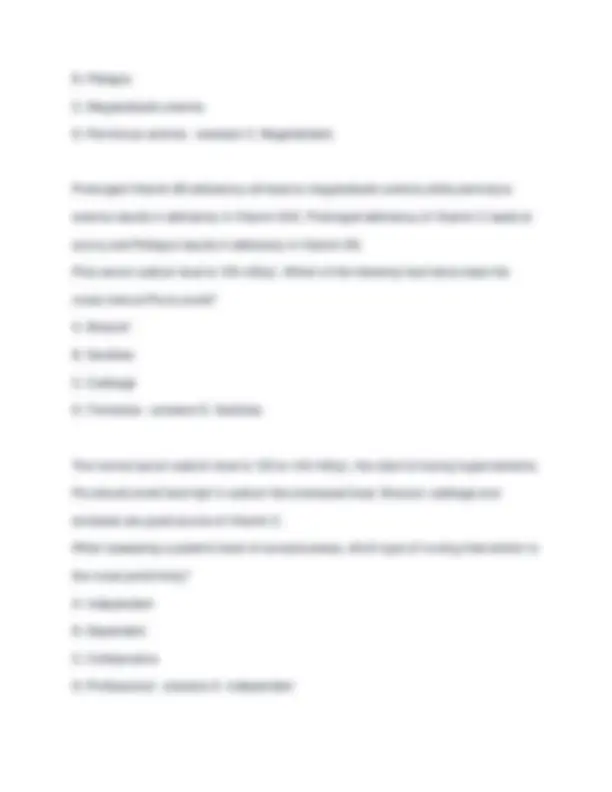
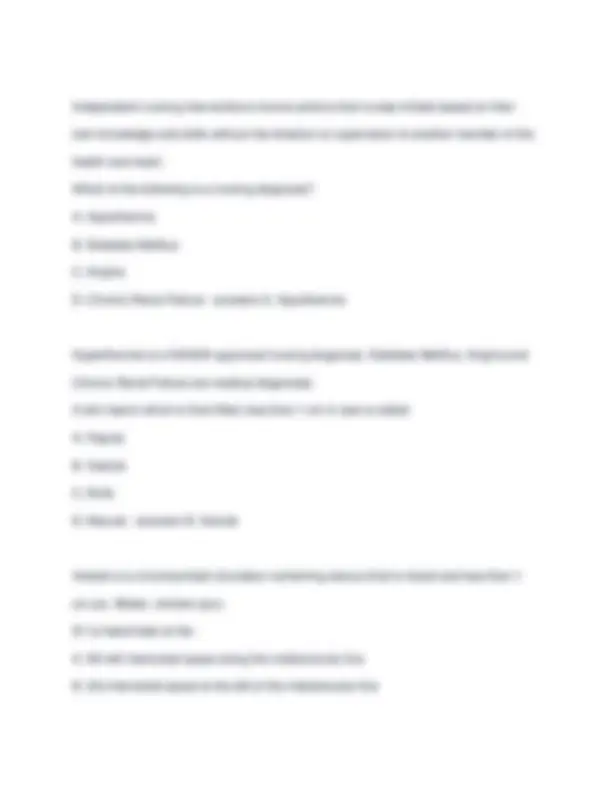
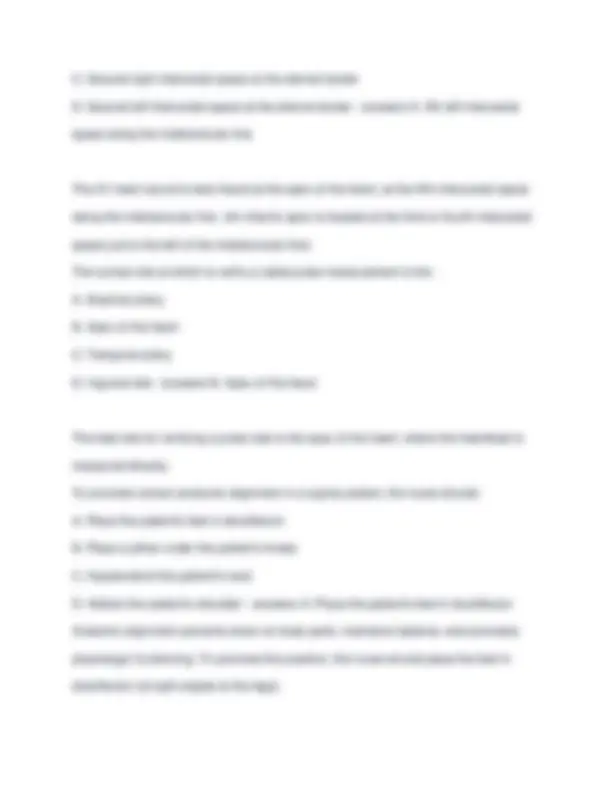
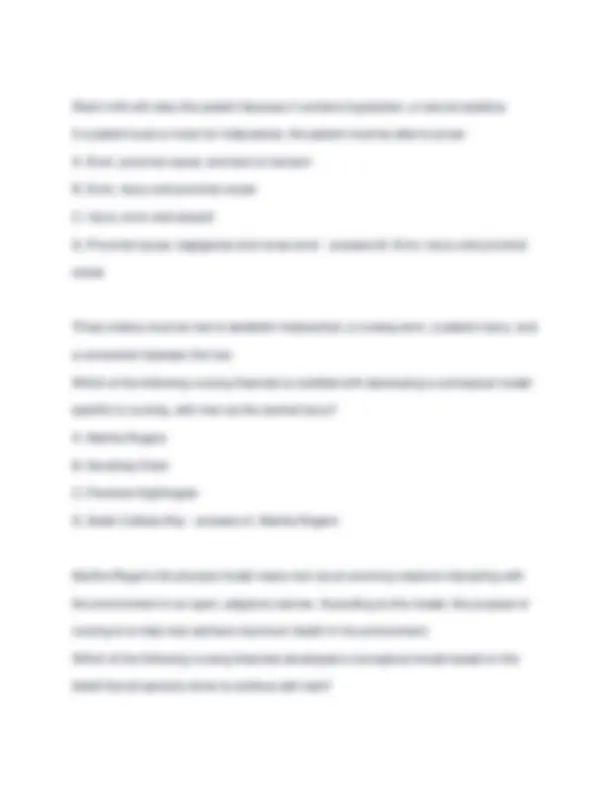
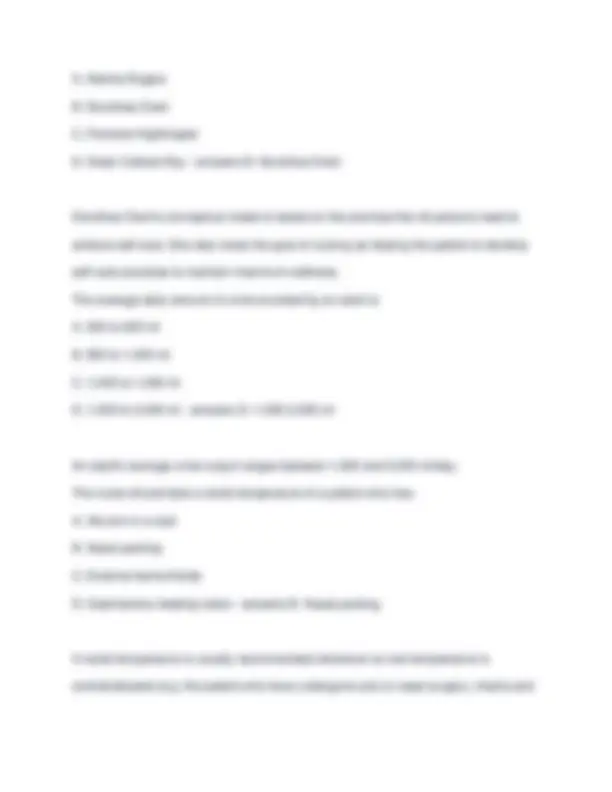
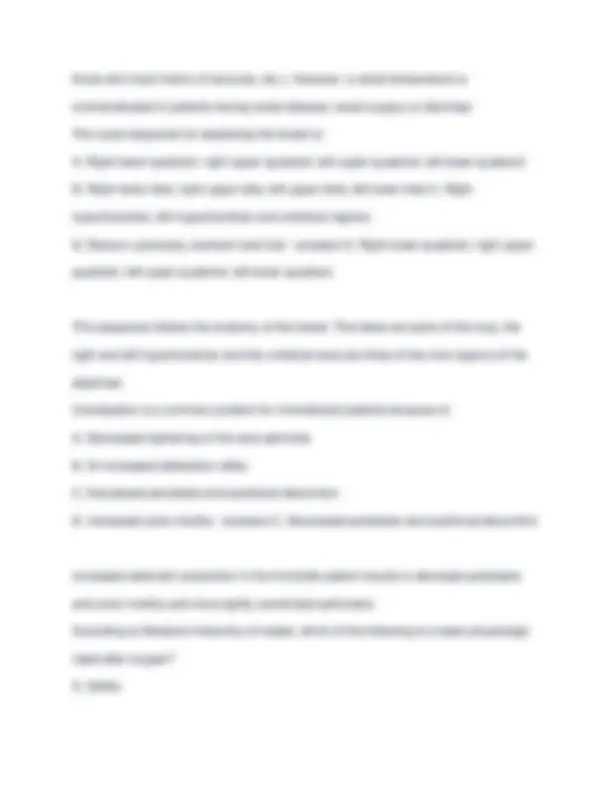
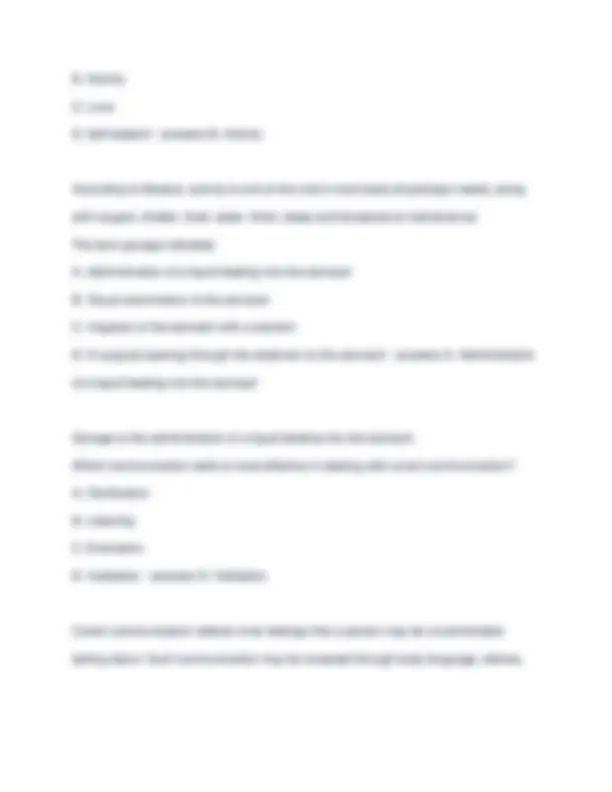
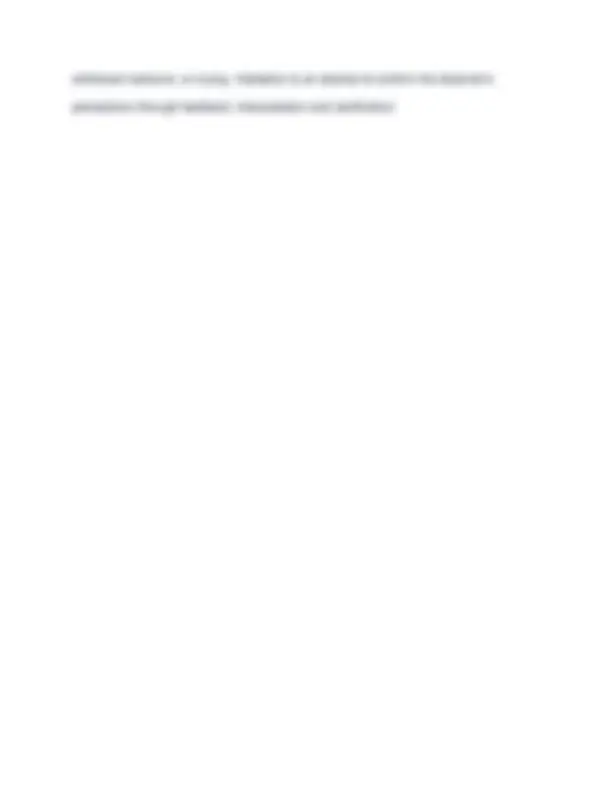


Study with the several resources on Docsity

Earn points by helping other students or get them with a premium plan


Prepare for your exams
Study with the several resources on Docsity

Earn points to download
Earn points by helping other students or get them with a premium plan
Community
Ask the community for help and clear up your study doubts
Discover the best universities in your country according to Docsity users
Free resources
Download our free guides on studying techniques, anxiety management strategies, and thesis advice from Docsity tutors
The role of a nurse as a change agent and an expert, based on benner's theory. It discusses the ability of expert nurses to perceive situations intuitively and the concept of secondary prevention. Additionally, it covers various nursing diagnoses and procedures.
Typology: Exams
1 / 22

This page cannot be seen from the preview
Don't miss anything!















During a physical assessment, the nurse closes and door and provides drape to promote privacy. The nurse is performing her role as a/an: A. Advocate B. Communicator C. Change agent D. Caregiver - answers D. Caregiver The role of a nurse as caregiver helps client promote, restore and maintain dignity, health and wellness by viewing a person holistically. As an advocate the nurse intercedes or works on behalf of the client. Identifying the need and problems of the client and communicating it to other members of the health team is doing the role of a communicator. As a change agent, the nurse assists the client to MODIFY their BEHAVIOR. During the nursing rounds Nurse Cathy is instructing the patient to avoid smoking to prevent the worsening of respiratory problems. The patient asked about the things that he can do when feelings of wanting to smoke arises. The nurse enumerates ways of dealing the situation. This is an example of a nurse's role as a/an: A. Advocate
B. Clinician C. Change agent D. Caregiver - answers C. Change agent As a change agent, the nurse assists the client to MODIFY their BEHAVIOR. As an advocate the nurse intercedes or works on behalf of the client. As a clinician, the nurse would use technical expertise to administer nursing care. The role of a nurse as caregiver helps client promote, restore and maintain dignity, health and wellness by viewing a person holistically. Nurse Cathy on the other hand, knows the case immediately even before a diagnosis is done. Based on Benner's theory she is a/an: A. Novice B. Expert C. Competent D. Advanced beginner - answers B. Expert The ability to perceive something without further evidence is the development of intuition and is seen in Expert nurses. A novice nurse is governed by rules and usually inflexible. Competent nurses are planning nursing care consciously. Advanced beginners demonstrate acceptable performance. Newborn screening is done to every newborn in the Philippines. This is an example of: A. Primary prevention B. Secondary prevention C. Tertiary prevention
Presence of both actual and high-risk diagnosis is called a syndrome nursing diagnosis. Wellness nursing diagnosis focuses on the clinical judgment on an individual from a specific to higher level of wellness. Actual diagnoses are clinical judgment of the nurse that is validated. A risk diagnosis is based on the clinical are based on clinical judgment that the client may develop vulnerability to the problem. The nurse in charge measures a patient's temperature at 101 degrees F. What is the equivalent centigrade temperature? A. 36.3 degrees C B. 37.95 degrees C C. 40.03 degrees C D. 38.01 degrees C - answers B. 37. To convert °F to °C use this formula, ( °F - 32 ) (0.55). While when converting °C to °F use this formula, ( °C x 1.8) + 32. Note that 0.55 is 5/9 and 1.8 is 9/5. During a change-of-shift report, it would be important for the nurse relinquishing responsibility for care of the patient to communicate. Which of the following facts to the nurse assuming responsibility for care of the patient? A. That the patient verbalized, "My headache is gone." B. That the patient's barium enema performed 3 days ago was negative C. Patient's NGT was removed 2 hours ago D. Patient's family came for a visit this morning. - answers C. Patient's NGT was removed 2 hours ago
The change-of-shift report should indicate significant recent changes in the patient's condition that the nurse assuming responsibility for care of the patient will need to monitor. The other options are not critical enough to include in the report A client is receiving 115 ml/hr of continuous IVF. The nurse notices that the venipuncture site is red and swollen. Which of the following interventions would the nurse perform first? A. Stop the infusion B. Call the attending physician C. Slow that infusion to 20 ml/hr D. Place a cold towel on the site - answers A. Stop the infusion The sign and symptoms indicate extravasation so the IVF should be stopped immediately and put warm not cold towel on the affected site. Which data would be of greatest concern to the nurse when completing the nursing assessment of a 68-year-old woman hospitalized due to Pneumonia? A. Oriented to date, time and place B. Clear breath sounds C. Capillary refill greater than 3 seconds and buccal cyanosis D. Hemoglobin of 13 g/dl - answers C. Capillary refill greater than 3 seconds and buccal cyanosis
A. Use sterile gloves when obtaining urine B. Open the drainage bag and pour out the urine C. Disconnect the catheter from the tubing and get urine D. Aspirate urine from the tubing port using a sterile syringe - answers D. Aspirate urine from the tubing port using a sterile syringe The nurse should aspirate the urine from the port using a sterile syringe to obtain a urine specimen. Opening a closed drainage system increase the risk of urinary tract infection. Jake is complaining of shortness of breath. The nurse assesses his respiratory rate to be 30 breaths per minute and documents that Jake is tachypneic. The nurse understands that tachypnea means: A. Pulse rate greater than 100 beats per minute B. Blood pressure of 140/ C. Respiratory rate greater than 20 breaths per minute D. Frequent bowel sounds - answers C. Respiratory rate greater than 20 breaths per minute A respiratory rate of greater than 20 breaths per minute is tachypnea. A blood pressure of 140/90 is considered hypertension. Pulse greater than 100 beats per minute is tachycardia. Frequent bowel sounds refer to hyper-active bowel sounds. Formulating a nursing diagnosis is a joint function of: A. Patient and relatives
B. Nurse and patient C. Doctor and family D. Nurse and doctor - answers B. Nurse and patient Although diagnosing is basically the nurse's responsibility, input from the patient is essential to formulate the correct nursing diagnosis. The nurse listens to Mrs. Sullen's lungs and notes a hissing sound or musical sound. The nurse documents this as: A. Wheezes B. Rhonchi C. Gurgles D. Vesicular - answers A. Wheezes Wheezes are indicated by continuous, lengthy, musical; heard during inspiration or expiration. Rhonchi are usually coarse breath sounds. Gurgles are loud gurgling, bubbling sound. Vesicular breath sounds are low pitch, soft intensity on expiration. Becky is on NPO since midnight as preparation for blood test. Adreno-cortical response is activated. Which of the following is an expected response? A. Low blood pressure B. Warm, dry skin C. Decreased serum sodium levels D. Decreased urine output - answers D. Decreased urine output
During application of medication into the ear, which of the following is inappropriate nursing action? A. In an adult, pull the pinna upward B. Instill the medication directly into the tympanic membrane C. Warm the medication at room or body temperature D. Press the tragus of the ear a few times to assist flow of medication into the ear canal
A. 2nd CN (Optic) B. 3rd CN (Occulomotor) C. 4th CN (Trochlear) D. 7th CN (Facial) - answers D. 7th CN (Facial) Bells' palsy is the paralysis of the motor component of the 7th cranial nerve, resulting in facial sag, inability to close the eyelid or the mouth, drooling, flat naso-labial fold and loss of taste on the affected side of the face. When performing an admission assessment on a newly admitted patient, the nurse percusses resonance. The nurse knows that resonance heard on percussion is most commonly heard over which organ? A. Thigh B. Liver C. Intestine D. Lung - answers D. Lung Resonance is loud, low-pitched and long duration that's heard most commonly over an air-filled tissue such as a normal lung. To assess the adequacy of food intake, which of the following assessment parameters is best used? A. Food preferences B. Regularity of meal times C. 3-day diet recall
B. Pellagra C. Megaloblastic anemia D. Pernicious anemia - answers C. Megaloblastic Prolonged Vitamin B9 deficiency will lead to megaloblastic anemia while pernicious anemia results in deficiency in Vitamin B12. Prolonged deficiency of Vitamin C leads to scurvy and Pellagra results in deficiency in Vitamin B3. Pia's serum sodium level is 150 mEq/L. Which of the following food items does the nurse instruct Pia to avoid? A. Broccoli B. Sardines C. Cabbage D. Tomatoes - answers D. Sardines The normal serum sodium level is 135 to 145 mEq/L, the client is having hypernatremia. Pia should avoid food high in sodium like processed food. Broccoli, cabbage and tomatoes are good source of Vitamin C. When assessing a patient's level of consciousness, which type of nursing intervention is the nurse performing? A. Independent B. Dependent C. Collaborative D. Professional - answers A. Independent
Independent nursing interventions involve actions that nurses initiate based on their own knowledge and skills without the direction or supervision of another member of the health care team. Which of the following is a nursing diagnosis? A. Hypothermia B. Diabetes Mellitus C. Angina D. Chronic Renal Failure - answers A. Hypothermia Hyperthermia is a NANDA-approved nursing diagnosis. Diabetes Mellitus, Angina and Chronic Renal Failure are medical diagnoses. A skin lesion which is fluid-filled, less than 1 cm in size is called: A. Papule B. Vesicle C. Bulla D. Macule - answers B. Vesicle Vesicle is a circumscribed circulation containing serous fluid or blood and less than 1 cm (ex. Blister, chicken pox). S1 is heard best at the: A. 5th left intercostal space along the midclavicular line B. 3rd intercostal space to the left of the midclavicular line
Postural drainage to relieve respiratory congestion should take place: A. Before meals B. After meals C. At the nurse's convenience D. At the patient's convenience - answers A. Before meals Postural drainage is best performed before, rather after meals to avoid tiring the patient or inducing vomiting. The patient's safety supersedes the convenience in scheduling this procedure. Mr. Jose is admitted to the hospital with a diagnosis of pneumonia and COPD. The physician orders an oxygen therapy for him. The most comfortable method of delivering oxygen to Mr. Jose is by: A. Croupette B. Nasal cannula C. Nasal catheter D. Partial rebreathing mask - answers B. Nasal cannula The nasal cannula is the most comfortable method of delivering oxygen because it allows the patient to talk, eat and drink. The nurse's main priority when caring for a patient with hemiplegia? A. Educating the patient B. Providing a safe environment C. Promoting a positive self-image
D. Helping the patient accept the illness - answers B. Providing a safe environment A patient with hemiplegia (paralysis of one side of the body) has a high risk of injury because of his altered motor and sensory function, so safety is the nurse's main priority. A sudden redness of the skin is known as: A. Flush B. Cyanosis C. Jaundice D. Pallor - answers A. Flush Flush is a sudden redness of the skin. Cyanosis is a slightly bluish, grayish skin discoloration caused by abnormal amounts or reduced hemoglobin in the blood. Jaundice is a yellow discoloration of the skin, mucous membranes and sclera caused by excessive amounts of bilirubin in the blood. Pallor is an unnatural paleness or absence of color in the skin indicating insufficient oxygen and excessive carbon dioxide in the blood. A patient states that he has difficulty sleeping in the hospital because of noise. Which of the following would be an appropriate nursing action? A. Administer a sedative at bedtime, as ordered by the physician B. Ambulate the patient for 5 minutes before he retires C. Give the patient a glass of warm milk before bedtime D. Close the patient's door from 9pm to 7am - answers C. Give the patient a glass of warm milk before bedtime
A. Martha Rogers B. Dorothea Orem C. Florence Nightingale D. Sister Callista Roy - answers B. Dorothea Orem Dorothea Orem's conceptual model is based on the premise that all persons need to achieve self-care. She also views the goal of nursing as helping the patient to develop self-care practices to maintain maximum wellness. The average daily amount of urine excreted by an adult is: A. 500 to 600 ml B. 800 to 1,400 ml C. 1,000 to 1,200 ml D. 1,500 to 2,000 ml - answers D. 1,500-2,000 ml An adult's average urine output ranges between 1,500 and 2,000 ml/day. The nurse should take a rectal temperature of a patient who has: A. His arm in a cast B. Nasal packing C. External hemorrhoids D. Gastrostomy feeding tubes - answers B. Nasal packing A rectal temperature is usually recommended whenever an oral temperature is contraindicated (e.g. the patient who have undergone oral or nasal surgery, infants and
those who have history of seizures, etc.). However, a rectal temperature is contraindicated in patients having rectal disease, rectal surgery or diarrhea) The usual sequence for assessing the bowel is: A. Right lower quadrant, right upper quadrant, left upper quadrant, left lower quadrant B. Right lower lobe, right upper lobe, left upper lobe, left lower lobe C. Right hypochondriac, left hypochondriac and umbilical regions D. Rectum, pancreas, stomach and liver - answers A. Right lower quadrant, right upper quadrant, left upper quadrant, left lower quadrant This sequence follows the anatomy of the bowel. The lobes are parts of the lung. the right and left hypochondriac and the umbilical area are three of the nine regions of the abdomen. Constipation is a common problem for immobilized patients because of: A. Decreased tightening of the anal sphincter B. An increased defecation reflex C. Decreased peristalsis and positional discomfort D. Increased colon motility - answers C. Decreased peristalsis and positional discomfort Increased adrenalin production in the immobile patient results in decrease peristalsis and colon motility and more tightly constricted sphincters. According to Maslow's hierarchy of needs, which of the following is a basic physiologic need after oxygen? A. Safety